Van Gogh Museum Journal 2000
(2000)– [tijdschrift] Van Gogh Museum Journal–
[pagina 52]
| |
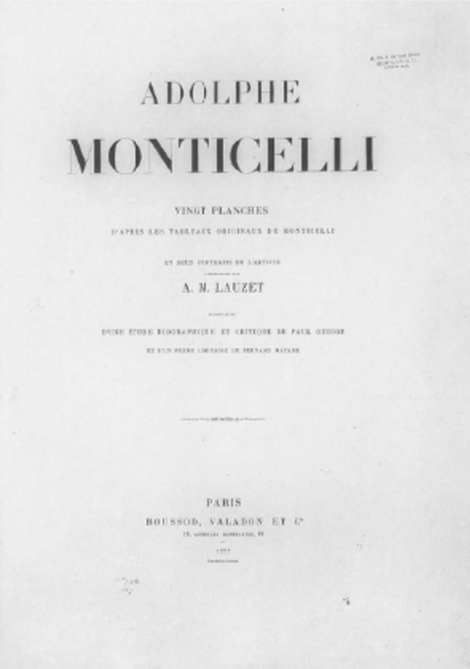 fig. 1
Title page of Adolphe Monticelli: vingt planches d'après les tableaux originaux de Monticelli et deux portraits de l'artiste, Paris 1890 | |
[pagina 53]
| |
Theo van Gogh, publisher: the Monticelli album
| |
[pagina 54]
| |
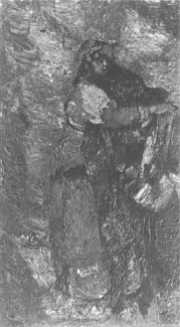 fig. 3
Adolphe Monticelli, The Italian girl, c. 1870, Amsterdam, Van Gogh Museum (Vincent van Gogh Foundation) information has come to light regarding the buyers of the album or its reception by the public or art writers. A list of subscribers has never been found, nor do we know how much it cost. The album's frontispiece shows Monticelli in profile, dressed in an elegant black velvet jacket with a wide-brimmed hat and cane. The portrait is based on a drawing by Jules Monge that was originally published in 1881 in an article by Adolphe Meyer in La Provence Artistique & Pittoresque, a weekly published in Marseille.Ga naar voetnoot7 Vincent and Theo had probably read this article, which suggested that Monticelli had suffered from a type of madness or folie at the end of his life. Lauzet's lithographs must be seen as ‘artistic’ rather than reproductive, and were printed in brownish tones by the Lemercier firm in Paris.Ga naar voetnoot8 They are quite different from the more photograph-like Goupil reproductions, and less original than expensive autonomous prints by other artist-printmakers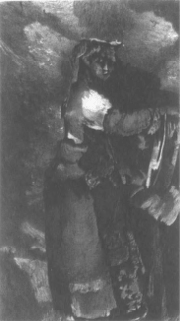 fig. 4
Auguste Lauzet, lithograph after Adolphe Monticelli's The Italian girl like Gauguin. In a manner comparable to the Monticelli album, Theo published Thornley's lithographs after Degas as a set in April 1888, bringing out another 15 in 1889. He also arranged the publication of a set of ten zincographes by Gauguin in January 1889, and he was interested in displaying and selling estampes originales by other artists as well.Ga naar voetnoot9 Boussod, Valadon's technical expert, Michel Manzi, was involved in all these promotions of original prints. Toulouse-Lautrec, for example, wrote his mother in January 1888 that Theo had sold one of his pictures to Manzi, who was planning to reproduce it in lithography or in a technique called photo-typogravure.Ga naar voetnoot10 Theo owned two of the paintings included in the Monticelli album. The first one he purchased was The Italian girl (fig. 3), a richly coloured and thickly painted depiction of a woman in an Italian or Provençal costume.Ga naar voetnoot11 Lauzet's lithograph sought to suggest the heavy application of paint in the original work (fig. 4). The other was Woman | |
[pagina 55]
| |
at a well (figs. 5 and 6). Theo probably intended to sell these two pictures, but his death intervened and they remained in his personal collection, which contained four other Monticellis as well. Two of these show fashionably dressed women. Woman with a parasol and The meeting are both projections of the fantasies of the artist, who longed to be surrounded by or to meet the kinds of women he painted.Ga naar voetnoot12 In addition, Theo owned Vase of flowers and an imaginary scene of Arabs and horsemen. All these works are now housed in the Van Gogh Museum in Amsterdam. Of the remaining 18 paintings lithographed, two - Halte de chasse (no. 9) and Rendez-vous en forêt (no. 19) - were in the collection of Madame Jeanne Dupuis, who may have been the wife of a certain Monsieur Dupuis, who was one of Theo's most important collectors of vanguard pictures.Ga naar voetnoot13 Another work in the album was owned by Charles Faure, who later helped organise the large Monticelli retrospective in the 1908 Salon d'Automne.Ga naar voetnoot14 Delarebeyrette, who ran a gallery in Paris that sold Monticellis, provided Lauzet with nine pictures for the album (nos. 5, 8, 11-13, 18, and 20-22). Theo may have wished to let the dealer showcase his works here as he had longstanding contacts with Monticelli and his agents. Alexander Reid, a Scottish Monticelli collector who had worked briefly at Boussod, Valadon and had roomed with Vincent for a short period, allowed one of his pictures to be reproduced.Ga naar voetnoot15 We cannot identify the owners of the other paintings included with any certainty. As noted above, the album appeared in the summer of 1890, at a difficult time in Theo and Vincent's lives. It coincided with Theo's struggles with the owners of Boussod, Valadon, his own failing health and the illness of his newborn child. Despite these financial and personal problems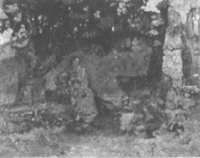 fig. 5
Adolphe Monticelli, Woman at a well, 1870-71, Amsterdam, Van Gogh Museum (Vincent van Gogh Foundation) 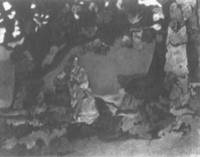 fig. 6
Auguste Lauzet, lithograph after Adolphe Monticelli's Woman at a well | |
[pagina 56]
| |
he made certain the album was completed, printed and distributed to its subscribers and buyers. Vincent welcomed the album as a kind of rescue of the old Marseilles painter. The rumours about Monticelli's madness had long troubled him; his letters from Arles and Saint-Rémy often touch upon the matter.Ga naar voetnoot16 | |
Theo as a Monticelli dealerTheo had begun trading in Monticellis in 1886 and over the next four years he sold a large number. Although he sold far more pictures by Corot, Monet, Corcos and Daubigny, he seems to have been eager to become known as a Monticelli specialist.Ga naar voetnoot17 Publishing the album was intended both to promote his gallery as a venue where discerning collectors could buy fine paintings by the artist, and to enhance Monticelli's reputation as one of the foremost colourists of the French avant-garde. Monticelli's stature began to rise just at the time the album was being prepared. In 1886 he had been honoured by the Belgian group Les XX. In December 1885 Octave Maus contacted him in Marseilles, where the artist was still painting but was ill with the effects of two strokes, and invited him to show three of his late pictures at their exhibition in Brussels in July the following year. Monticelli's letter of acceptance expressed his personal appreciation for this recognition.Ga naar voetnoot18 Vincent, incidentally, was invited to show with Les XX in 1890. Theo, Vincent, Delarebeyrette and Reid naturally all knew of the Monticelli commemorative shows that took place in Great Britain in 1886.Ga naar voetnoot19 One of these was at the Edinburgh International Exhibition, where eight works were displayed. During the late summer of that year more and more dealers and collectors learned of Monticelli's death and became interested in buying his works. Not surprisingly, the legends surrounding Monticelli helped his sales. This trend continued. In 1888 a retrospective group of his works was exhibited at the Glasgow International exhibit. The gallery of Daniel Cottier was known for its Monticelli exhibitions during the late 1880s in London and New York. Also in London, Dowdeswell & Dowdswell showed 75 Monticellis in 1888. Reid, the French critic Phillipe Burty, and Oscar Wilde lent their Monticellis to this event.Ga naar voetnoot20 Theo usually bought his Monticelli paintings from Paris dealers or the artist's friends or agents in Marseilles. Monticelli's best-known Paris dealer was the elderly Joseph Delarebeyrette, who became ill in February 1886 and died on 20 September the same year. His widow - who may be the woman Vincent referred to in his letters as the ‘la Roquette female,’ whom he believed to have been responsible for spreading rumours about Monticelli's drinking habits [602/478] - and son, Gabriel (‘Gabriel de la Roquette’ [628/498]) continued to run the business. What we know of the gallery's Monticelli dealings after this time comes from the correspondence between Gabriel Delarebeyrette and Pierre Piquet, an old acquaintance of the artist who sent works to Paris dealers. In one of these notes Gabriel mentions that he had 37 Monticellis in stock in April 1884 and 43 in January 1885. On 4 July 1886 he wrote to Piquet to express his sadness at Monticelli's death.Ga naar voetnoot21 The Delarebeyrette gallery, located at 43, Rue de Provence, had been the chief place for collectors to purchase Monticellis before Theo became a major dealer in them around 1886.Ga naar voetnoot22 Delarebeyrette had known Monticelli since the 1860s, when the artist lived in Paris,Ga naar voetnoot23 and he continued to sell his pictures even after 1870, when the painter moved permanently to Marseilles. In 1883 Delarebeyrette, who had not seen Monticelli in many years, went to visit him. The dealer returned to Paris with a sampling of his brightly coloured and thickly painted work from the early 1880s. In the aftermath of Delarebeyrette's call, Piquet began sending more Monticellis to Paris. These were displayed in the dealer's three-room shop, which Vincent and Theo visited in 1886 and later. These acquisitions, and the replenishment of Delarebeyrette's stock with the even more daring works of 1884-86, introduced Theo, Reid, Vincent and other young artists - including Gauguin and Cézanne - to the artist's late style.Ga naar voetnoot24 Following a visit to the Delarebeyrette gallery soon after he arrived in Paris in the spring of 1886, Vincent began emulating Monticelli's work, particularly his flower still lifes. It is important to note that Vincent not only imitated the older artist's style, he also felt he was following in his footsteps both formally and psychologically. He believed there was a strange destiny in his discovery of Monticelli only months before the painter died.Ga naar voetnoot25 Many writers promulgated the notion that it was Monticelli's alcoholism and ‘madness’Ga naar voetnoot26 that were at the root of his pictures' ‘savage’ appearance and while in Paris, and later in Arles, Vincent tried to learn more about the artist's mental state at the time of his death in June 1886.Ga naar voetnoot27 Van Gogh might have seen such late ‘wild’ works as Sous les arbres (fig. 7), and these may have led him not only to wonder what had made the older | |
[pagina 57]
| |
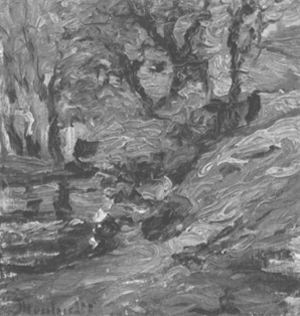 fig. 7
Adolphe Monticelli, Sous les arbres, c. 1883-85, Private collection | |
[pagina 58]
| |
painter adopt such an abstract and improvisational style, but also to question the validity of the rumours of Monticelli's madness. It may well have been Delarebeyrette who helped convince him that these stories were untrue.Ga naar voetnoot28 Theo's own activity in buying and selling Monticellis can be evaluated from the ledgers of Boussod, Valadon & Cie.Ga naar voetnoot29 He sold many to London dealers specialising in the artist's work, including Daniel Cottier and Dowdeswell & Dowdswell, who resold them at high prices.Ga naar voetnoot30 There were also sales to Glasgow, Edinburgh, New York and Boston. In 1888 a Monticelli was sold to the Goupil branch in The Hague, and there were also sales to E.J. van Wisselingh, the Amsterdam dealer.Ga naar voetnoot31 Theo's first Monticelli sale is listed in his account books on 2 February 1886, about a month before Vincent's arrival in Paris. It was of a pair of rococo-inspired pictures that had cost him 425 francs that he then sold for 600 to Thomas Richardson, a London dealer. Theo faced stiff competition in his quest to find and sell Monticellis. In addition to Delarebeyrette, there was the art dealer George A. Lucas, an American expatriate living in Paris who was Theo's rival in selling French pictures to wealthy foreigners. Lucas kept a diary of his activities and recorded how he bought inexpensive Monticellis in Paris and then sold them to clients in the United States. He purchased his first Monticelli for 35 francs in 1872 - the artist was already living in Marseille and sending works to Delarebeyrette. In 1882 he noted the purchase of two more pictures from the dealer, which he sent to the American collector Samuel Avery. On 22 March 1888 Lucas went to see some Monticelli work Theo had for sale, and five days later he wrote that he had again visited Delarebeyrette to look at some more.Ga naar voetnoot32 Theo scored a good financial success on a Monticelli sale to the London dealer Charles Obach and Company in 1886, bringing in 4,000 francs. This must have been very encouraging to Theo, who had paid 3,500 francs for the picture. He sold nine other works to Obach in April and September 1887. Most of these came from Delarebeyrette. The prices paid ranged from 150 to 1,400 francs. In May 1887 Theo sold seven paintings to the London Monticelli dealers Dowdeswell & Dowdswell. Again, most had been purchased from Delarebeyrette. Another supplier was Monsieur Boyer, who was Monticelli's principal agent in Marseilles.Ga naar voetnoot33 The Scottish dealer Alexander Reid bought six Monticellis from Theo in September 1887, at prices ranging from 100 to 250 francs. Thomas Richardson bought a third Monticelli from him in January 1890, and Vincent's friend, the artist Eugene Boch, bought three in July 1889, about a year after he and Vincent had painted together in Arles. One of Boch's paintings had been part of a group of six Theo had purchased from the Paris dealers Pierre-Firmin Martin and Camentron, at their gallery on the Rue Lafitte.Ga naar voetnoot34 Monticelli sales were naturally only a small part of Theo's business. However, the one Monticelli transaction for 4,000 francs was larger than most of his impressionist sales put together, with the exception of works by Monet and Degas.Ga naar voetnoot35 Theo bought most of his Monticellis for less than 300 francs, and several cost him less than 100. | |
The Monticelli album project: a chronologyThe Van Gogh correspondence provides the chronology of the Monticelli album-publishing venture. In a letter to Vincent dated 8 December 1889, Theo mentions Lauzet's visit and his plans for the album. He also reminded his brother that Vincent had once expressed a hope that someone would soon honour Monticelli: ‘At the time you used to say that they ought to publish a book on Monticelli. Well, I have seen a score of very fine lithographs after his pictures, done by a certain Lauzet. There will also be an accompanying text. The artist is going to have a look at our pictures to see whether there are any he might want to reproduce. [...] The lithographs are printed in different tones, and, with regard to the process used, are more or less like the etchings on stone which Marvy did in his time; the man who made them is a true artist’ [827/T21]. Vincent replied enthusiastically to the news of the publication: ‘What you tell me about a publication of coloured lithographs with a text on Monticelli is very interesting. Frankly, it gave me very great pleasure, and I shall be very curious to see them some day’ [830/617]. A week or so later Lauzet visited Theo again, and this was duly reported to Vincent on 22 December: ‘Mr Lauzet, the lithographer of Monticelli's pictures, came to see me at my home. He came to see ours, and he thought them very fine. As regards the flowers, he doesn't think he can reproduce them, for the slabs are monochrome, and he doesn't think he will be able to render the effect of that picture in a single colour. He will start with the “Italian woman.”’ He then went on to describe the lithographs Lauzet had showed him and the man himself: ‘I think he | |
[pagina 59]
| |
has been most successful in that head of a child which we saw at La Roquette'sGa naar voetnoot36 that time. The artist made a very sympathetic impression on me. He is from the south and has something of the Spaniard about him, a pale face with a black beard, but at the same time he has something gentle, like an English poet. It is a great pity that he has not done any slabs in different colours, which Monticelli was one of the first to use, availing himself of a contrast in order to arrive at a strong effect, while preserving the harmony’ [833/T22]. On 22 January 1890 Theo once more wrote Vincent on a visit from Lauzet. A tentative title for the album had been chosen, Monticelli: épreuve d'artiste, although this was later changed. He also told his brother that the artist had liked the new canvases Vincent had shipped from the asylum: ‘[...] after he had seen some pictures he exclaimed, “Isn't Provence lovely!”’ He mentioned that Lauzet had left Paris a few days earlier on his way to Marseilles, and that on his return he would try to stop in Saint-Rémy. Finally, he asked Vincent to inform the artist, if he did come to the asylum, that Theo had sold another subscription to the Monticelli book [844/T25]. By late January 1890 Theo had apparently decided to publish the album through Boussod, Valadon & Cie.Ga naar voetnoot37 Taking on the role of publisher must have been a difficult decision for him. He knew he was not likely to get financial support from his employers, with whom he was in dispute about a variety of issues. Most of the funding for the project had to be raised by subscriptions before printing. To sell these, Theo and Lauzet contacted Monticelli's admirers. Regarding the costs, Theo had, however, written to Vincent on 22 December 1889 that the album was ‘still far from completed, but [Lauzet] will finish it. Cottier and Reid have subscribed for several copies, so that his printing expenses are covered. He has got ready 16 of the 25 lithographs he intends to make’ [833/T22]. The Monticelli album was finally printed and distributed in late June 1890, about four weeks before Vincent shot himself. Theo wrote to his brother on 13 June: ‘Lauzet came yesterday morning to see your pictures; he is very busy with his Monticellis, which are to appear within some ten days’ [892/T37]. | |
Paul Guigou's text: rescuing MonticelliAn essay about Monticelli's life and his artistic goals was to complement the lithographs. Lauzet chose Paul Guigou for the task, an art writer and director of the museum in Marseilles.Ga naar voetnoot38 Guigou had known Monticelli during his time in the southern port. His essay expressed the wishes of the chief supporters of the album - Lauzet, Theo, Vincent and the other sponsors, in particular the Delarebeyrettes, Alex Reid and Cottier - who hoped it would rescue the artist from the rumours about his madness, alcoholism and eccentricity.Ga naar voetnoot39 Theo may have assisted Guigou in understanding Monticelli by putting him in contact with the artist's main dealers in Paris, the Delarebeyrettes. In one section of the essay, Guigou depicts Monticelli as a turbulent, bohemian painter and he describes him as an artist driven ‘mad’ by Gypsy music (although he also notes that he never seems to have suffered from any mental torment). In a footnote, however, the author writes that after receiving some letters from Monticelli to his Paris dealer - we do not know through whom - his views had changed. While he had previously | |
[pagina 60]
| |
thought Monticelli painted effortlessly, he now understood the amount of work that went in to achieving the artist's typically ‘wild’ look. He quotes Monticelli himself: ‘I can tell you that I do not just paint for my personal pleasure, absolutely, and that only rarely do I make a picture that makes me dream of a certain mood. [...] Speaking seriously, I don't just make my paintings from air, and they require more effort than you can believe.’Ga naar voetnoot40 Clearly, all those involved in the project wanted to stress that Monticelli's style was intentional and not the result of illness. | |
Vincent and the Monticelli albumIn January 1890, while the album was being prepared, Albert Aurier published his essay on Van Gogh as an ‘isolated’ and visionary artist. Vincent wrote to the art critic that he was grateful for the attention, but felt he should point out his psychological and stylistic debt to Monticelli, stressing how sensitive he was to his plight as an artist who had died unappreciated: ‘It seems to me that Monticelli's personal artistic temperament is exactly the same as that of the author of The Decameron - Boccaccio - a melancholic, somewhat resigned, unhappy man, who saw the wedding party of the world pass by, painting and analysing the lovers of his time - he, the one who had been left out of things’ [854/626a]. Vincent then urged Aurier to think of Monticelli as his mentor: ‘I feel uneasy in my mind when I reflect that what you say is due to others rather than to myself. For example, Monticelli in particular. Saying as you do: “As far as I know, he is the only painter to perceive the chromatics of things with such intensity, with such a metallic, gemlike lustre,” be so kind as to go and see a certain bouquet by Monticelli at my brother's - a bouquet in white, forget-me-not blue and orange - then you will feel what I want to say. But the best, the most amazing Monticellis have long been in Scotland and England. In a museum in the north - the one in Lille I believe - there is said to be a very marvel, rich in another way and certainly no less French than Watteau's Départ pour Cythère. At the moment Mr Lauzet is engaged in reproducing some 30 works of Monticelli's’ [854/626a]. By 1890 Vincent had another personal motive for desiring the Monticelli album to be published: he hoped that Dr Gachet would print a companion volume of etchings of his own pictures on Provençal subjects.Ga naar voetnoot41 Gachet owned an etching press that could be used to print the sequel album, and he had also known Monticelli many years earlier, when he was a medical student in Montpellier. The two probably met in Marseilles in 1858.Ga naar voetnoot42 John Rewald has even suggested that Vincent became closer to Gachet when he learned that he had been acquainted with MonticelliGa naar voetnoot43 and had actually painted and etched some portraits of the older artist.Ga naar voetnoot44 The artist may have thought that the ‘Vincent album’ would establish a further link between himself and Monticelli. In a letter he mentions that once when he was painting a picture of Provençal women gathering olives he thought the picture, reproduced in a lithograph, could one day be part of a sequel album dedicated to himself and similar to Lauzet's work on Monticelli [830/617]. Such a pairing of albums would serve to emphasise that both artists had worked in Provence and had been considered madmen because of the appearance of their paintings and their eccentric behaviour, but also to prove this image wrong. Vincent hoped that once Lauzet had finished the Monticelli album he would be interested in working on this second album. He was encouraged in his hopes by Theo, who had written several times that Lauzet was an admirer: ‘But what pleased him most were your canvases and drawings; oh, my dear fellow, that man understands them!’ [833/T22]. In a later letter he noted that he was sure Lauzet would appreciate Vincent's new drawings when he came to visit the apartment next [840/T24]. He even went so far as to suggest that Vincent and Lauzet might rent a studio together [844/T25]. Vincent's plan for his own album was maturing just at the time when he may have had the opportunity to see a printer's proof copy of the Monticelli book on his way to Auvers in the third week of May 1890, when he stopped in Paris to visit Theo. Vincent wrote Gauguin on 16 June that he was thinking of etching images he had done in Provence [893/643]. In a letter to Theo of 17 June, with the publication date of the Monticelli album drawing near, Vincent returned to the idea of printing some of his own pictures, probably on Gachet's press, as a follow-up. He also hoped that Gauguin would collaborate on the new volume: ‘I hope [Gauguin] does some etchings of southern subjects, say six, since I can print them without cost at M. Gachet's, who is kind enough to print them for nothing if I do them. That is certainly something that ought to be done, and we will do it in such a way that it will form a sort of sequel to the Lauzet-Monticelli publication, if you approve. And Gauguin will probably engrave some of his canvases in conjunction with me [...]. Gachet will print these plates for us too [...]. | |
[pagina 61]
| |
[He] is coming to see my canvases in Paris someday and then we could choose some of them for engraving’ [894/642]. Vincent may have seen the finished copies of the Monticelli album when went to visit Theo in Paris on 6 July.Ga naar voetnoot45 By late July Vincent had quarrelled with Gachet and there was apparently no further hope that he could produce prints after his own paintings on the doctor's press.
Theo and Lauzet probably spent several weeks distributing copies of the Monticelli album to subscribers. This heroic rescue of the Marseilles painter was one of the dealer's most important acts in the last months of his life. Theo was worried about his future activities with Boussod, Valadon.Ga naar voetnoot46 In addition, he was terminally ill - and would soon be committed to an asylum in Utrecht.Ga naar voetnoot47 Vincent was of course pleased that the album had finally been released, and that Monticelli was at last honoured with a publication. By the summer of 1890, when the volume was being sent out from Theo's his gallery and sold to the general public, Vincent was preoccupied with his own posthumous reputation and consumed with fear that he, like Monticelli, would be viewed as a mad artist. At the time of his death he at least had the satisfaction of knowing that Theo had carried out one of his deepest personal wishes and published a book on Monticelli. |
|


